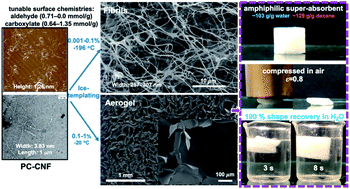Tunable dialdehyde/dicarboxylate nanocelluloses by stoichiometrically optimized sequential periodate–chlorite oxidation for tough and wet shape recoverable aerogels†
Abstract
Sequential periodate–chlorite (PC) oxidation has been optimized stoichiometrically according to the non-crystalline content in cellulose to generate a variety of versatile C2,C3 dialdehyde/dicarboxylate nanocelluloses (NCs) while economizing chemical and shear force inputs. The robust primary sodium periodate (NaIO4) oxidation not only regioselectively cleaved the C2–C3 carbon bond to oxidize the vicinal hydroxyls to aldehydes, but also governed the lengths of NCs, i.e., cellulose nanofibrils (PC-CNFs) at near-equal NaIO4 to non-crystalline anhydroglucose unit (AGU) stoichiometry and cellulose nanocrystals (PC-CNCs) at a doubled ratio. Secondary sodium chlorite (NaClO2) oxidation facilely converted C2,C3 dialdehydes to dicarboxylates and, upon deprotonation, facilitated defibrillation to NCs, irrespective of extents of carboxylation or charges. The optimal 0.5 : 1 NaIO4/AGU and 1 : 1 NaClO2/AGU oxidation produced highly uniform 1.26 nm thick, 3.28 nm wide, and ca. 1 μm long PC-CNFs with tunable surface aldehyde (0.71–0.0 mmol g−1) and carboxylate (0.64–1.35 mmol g−1) content at 94–98% yields. The C2–C3 glucosidic ring opening and oxidation along the 110 or 1![[1 with combining macron]](https://www.rsc.org/images/entities/char_0031_0304.gif) 0 crystalline surfaces increased the heterogeneity of the hydrophilic surfaces and flexibility of PC-CNFs to influence their self-assembling into fibrils and amphiphilic superabsorbent aerogels. The ultra-light (ρ = 10.3 mg cm−3) aerogels showed an ultra-high dry specific compression modulus (50.2 kPa mg−1 cm−3) and specific stress (8.2 kPa mg−1 cm−3 at 0.8 strain), cyclic wet compressive behavior, and excellent water-activated shape recovery following 0.8 strain dry compression.
0 crystalline surfaces increased the heterogeneity of the hydrophilic surfaces and flexibility of PC-CNFs to influence their self-assembling into fibrils and amphiphilic superabsorbent aerogels. The ultra-light (ρ = 10.3 mg cm−3) aerogels showed an ultra-high dry specific compression modulus (50.2 kPa mg−1 cm−3) and specific stress (8.2 kPa mg−1 cm−3 at 0.8 strain), cyclic wet compressive behavior, and excellent water-activated shape recovery following 0.8 strain dry compression.



 Please wait while we load your content...
Please wait while we load your content...